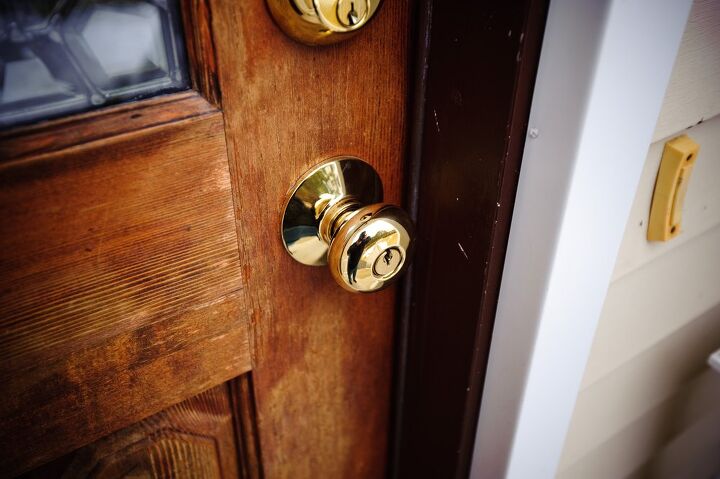What Color Do You Paint the Door Jamb? (Find Out Now!)

Home is where the heart is. But it’s also where all the hard work is. Repainting or renovating a home can be quite a task. So, what color do you paint the door jamb, and why does it even matter?
No rule says you have to paint your door jamb a specific color. However, you should paint a door jamb white in most cases. That’s because it helps freshen the look of your home. It also accentuates the color of your door and roof.
Do You Need a Window and Door Contractor?
Get free, zero-commitment quotes from pro contractors near you.

Do You Paint Door Jambs?
You don’t have to paint your door jambs at all. You can leave the edges of your door unpainted if you prefer the natural aesthetic. But don’t forget that unpainted trim can become problematic in bad weather. Untreated wood is especially prone to warping after heavy rain.
So, either paint your door jambs or finish them with a sealant. If possible, use paint and primer in one. Then, cover the dried finish with an exterior sealant to prevent discoloration, warping, and mold.
Meanwhile, keep a bit of paint for touchups later. You can also use the extra paint to match colors next season. Remember, your door jambs may look great after you paint them this year. But they’ll likely need a fresh coat in about 12-24 months.
TIP: Compare several types of exterior paint to find one that’s top-rated for the climate at your home.
What Color Should Door Jambs Be?
Your door jamb can be any color you choose. But many people choose stark white paint because it highlights other features of their home. White is also the color of most windows. So, painting your door jambs white is a great way to coordinate everything.
Use a different color than white if you want to. But try to pick something that matches or coordinates with your windows. And if you need help comparing colors, talk to someone in the paint department at your local hardware store.
Do You Have to Take Off a Door to Paint the Jamb?
You’ll need access to the entire door frame when you get ready to paint the jamb. That means you’ll most likely have to take the door off of its hinges. If you choose to leave the door alone, be prepared for some unpainted and unsightly spots.
Taking a door off its hinges may be difficult for people who cannot hold heavy objects. So, ask someone for help before you do it. And as always, wait for the paint to dry before rehanging the door.
TIP: Some stores sell paints that help hide imperfections. So, look at those options if you choose not to remove the door from its hinges.
How to Paint Door Jambs Like a Pro
Painting the edges of a door can be tricky. Firstly, you don’t want to get paint all over your beautiful door. Secondly, you don’t want a bunch of brush strokes and bubbles in the finish. So, how do you paint a door jamb like you know what you’re doing? It’s easy.
Follow these # simple steps to make your door jambs look like a professional painted them:
Step 1: Paint All the Flat Edges First
The flat edges of your door jamb may be the hardest to paint. That means you should start with them first. So, cover your brush and begin at the top, dragging your paint down as you move. That technique will help you conserve resources and get more done.
Step 2: Move to the Sides Next
After you get done painting all the edges, start painting the sides. You’ll probably notice several ridges that need to be covered. Attack them one at a time from top to bottom, so you don’t miss a spot. And if you do forget something, go back and touch it up after the paint dries.
Step 3: Apply a Second Coat When the First One Dries
Most door jambs require at least two coats of paint to look good. However, that all depends on the type of paint you use. High-quality exterior colors may not spread as quickly, but they usually cover better. Find the right balance for a professional finish.
Should I Use a Brush or Roller to Paint Door Edges?
It’s probably not a good idea to paint door jambs with a spray painter. That’s because it could get paint particulates all over everything else. That also means it’s best to use a paintbrush or paint roller instead. But which one is better?
It all depends on how you want your door jamb to look. Brushes may cause strokes in the paint, while rollers usually don’t. However, rollers may be too big to fit into specific areas. So, use a combination of both to produce the best results.
TIP: You can use a wedged sponge to paint hard-to-reach places.
Make Your Door Jams Pop
When painting a door jamb, be sure to pick a color that pops. Paint it whatever you like, but also try to coordinate the stain with your windows and roof. And if all else fails, hire a pro to do the hard work for you.
Do You Need a Window and Door Contractor?
Get free, zero-commitment quotes from pro contractors near you.

Related Questions
How Do You Avoid Brush Strokes When Painting?
Avoid brush strokes by collecting plenty of paint. Do not spread your paint too thin, or it might produce streaks and stroke marks. You can also check the type of paint to make sure it’s self-leveling.
Should I Sand a Door Jamb Before Painting It?
As always, a smooth surface is better for painting. So, it probably won’t hurt for you to sand the jamb before applying paint. However, the need for sanding depends on the type of door you have. Some door materials do not require pre-paint sanding.
Related Guides

Tiffany Nichols specializes in aesthetics, design, marketing, and manufacturing. She's a copywriter and editor for several home renovation companies in the U.S. and works alongside some of the biggest names in the industry. Her hobbies include architecture, art, mental health, and fashion.
More by Tiffany Nichols












![Finishing Basement Without Permit [Is It Really Illegal?]](https://cdn-fastly.upgradedhome.com/media/2023/07/31/9070078/finishing-basement-without-permit-is-it-really-illegal.jpg?size=350x220)














